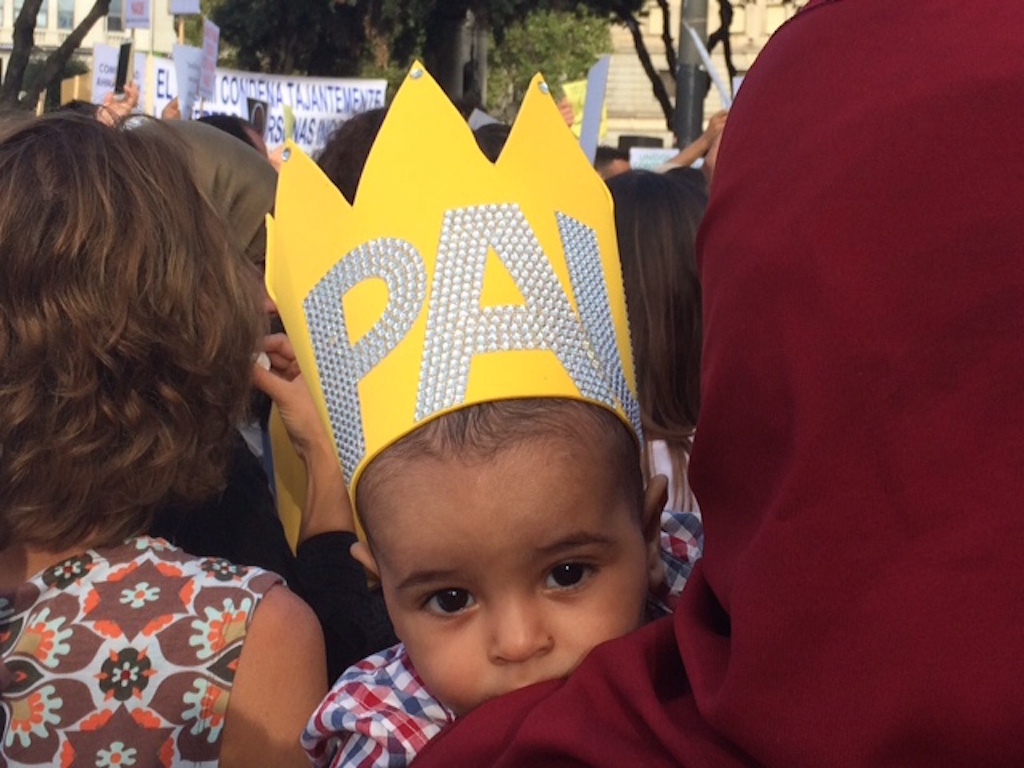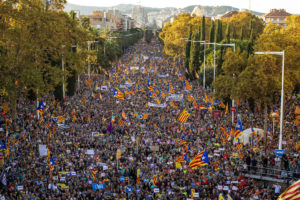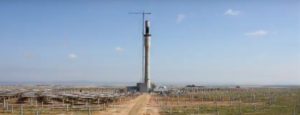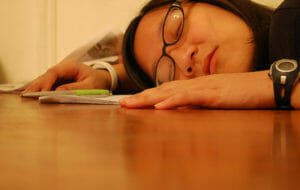Barcelona, After the Cameras Went Home
Before the Aug. 17 terrorist attacks, people would walk in the middle of the old quarter's narrow streets. Now they hug the sidewalks. A baby at a peace demonstration organized by Barcelona's Muslim community after the Aug. 17 terrorist attacks. Her crown says "peace" in Catalan. (Cate Swillinger)
A baby at a peace demonstration organized by Barcelona's Muslim community after the Aug. 17 terrorist attacks. Her crown says "peace" in Catalan. (Cate Swillinger)
Barcelona is no stranger to terrorism, but the Aug. 17 attacks have left their mark on this city.
Two days after the attacks, people gathered in the city’s central Plaza Catalunya to grieve as the chaos and shock began to subside. They held signs and chanted: “We are not afraid!”
But as I process what happened, I can’t figure out how anyone can not be afraid. Are they denying their vulnerability to future attacks? Do they actually believe that it won’t ever happen again? Or are they afraid and just pretending they aren’t?
I am an American who has lived in Barcelona for 25 years. I live next to the city’s famous Sagrada Familia cathedral, the terrorists’ original intended target. As I left my house the Sunday morning after the attacks, I was paralyzed by the sight of dozens of armored police vans and SWAT teams with machine guns. I panicked, thinking I had stepped into another attack, and frantically tried to assess where I could go to “be safe.” As it turned out, the police were there to protect King Felipe and Queen Letizia of Spain, the Spanish president and other local dignitaries attending a special Mass at the iconic church to honor the city and the victims. But just seeing the flashing police lights and men in riot gear was enough to petrify me.
Normally in Barcelona, people return from their summer holidays at the end of August and exchange stories of where they’ve been. Sadly, this year it’s different. Like any community that lives through a disaster, the thread that binds us now is sharing where we were and how we responded to the attacks. Not surprisingly, everyone is sad, shocked and outraged. What does surprise me was that nearly everyone I’ve spoken to also says they can’t believe that it didn’t happen sooner, just like in France, the U.K., Germany, Sweden, Belgium and Finland. It breaks my heart that we’ve become so desensitized to terrorism that we’ve come to expect it.
I am looking for ways to feel less victimized, afraid and anxious. So I decided to attend a demonstration organized by the local Muslim community, whose banners read: “Not in our name” and “Islam is peace.” Catalunya’s Muslim community must be even more afraid than I am, and its members’ expression of gratitude to the police during the demonstration seemed like a veiled plea for protection against Islamophobia fueled by people afraid of more attacks. That notion scares me as much as another attack does.
I also attended the march held by the city a few days later that ended at the attack site. The king and several national and Catalan politicians spoke at the event. On every street corner along the route, the city was giving away fresh roses. This was the first time I’ve ever seen the city give its people something other than free fireworks displays on local holidays. More than 500,000 people attended the march. That’s a lot of roses.
This event was billed as a peace gathering and a tribute to the attack victims. Unfortunately, other issues eclipsed the original motive of the gathering: the disapproval of the current Spanish monarchy, opposition to Spain’s weapons sales to other countries and disapproval of the national government’s position that the Catalan independence movement should be quashed because now more than ever, we need to unite as a nation.
The king’s speech was difficult to hear over the booing of the crowd. Unfortunately, the undertone of political tension competed with the reason we had all come together in the first place. In news photographs published after the gathering, the Catalan independence flags that had been flying behind the king were digitally removed. If you weren’t there, you would have thought that Barcelona was united against the common threat of terrorism. But for many of us who were there, it felt more like a Catalan call for independence than a display of national solidarity against terrorism.
But there was one beautiful moment of silence: People held their roses up in memory of the victims of the attack and the mayor of Barcelona paid homage to the local police forces by putting her rose on one of the armored vans parked on a corner for crowd control. Within 15 minutes, hundreds of people had followed suit, weaving their roses into the iron grates of the van’s bumpers.
What does Barcelona look like now? The Ramblas, where the attack took place, has become a memorial site, covered with flowers, photographs, gifts and prayers written on the sidewalk in chalk. But while some locals have gone to the area to pay their respects, others have avoided it because it’s just too painful to look at.
The city’s famous, once-crowded Boqueria market a few blocks up from the attack now seems muted. Even the way people walk in the surrounding Gothic quarter of the city has changed. Where they used to walk down the middle of the narrow, pedestrian-only streets, they now walk hugging the sidewalks, and a solemn air pervades the neighborhood. On one pedestrian shopping street that allows delivery vehicles, a friend witnessed a delivery van slowly turn down the street and a 5-year-old girl began to scream and cry when she saw it. As the girl’s father tried to calm her down, people nearby looked around frantically, trying to decide whether they needed to run for cover.
Newspapers have been reporting on places in and around Barcelona where street and sidewalk barriers have been installed to prevent similar attacks in the future, but everyone is left with the question: Is that enough?
A friend who is a police officer said that police switchboards have been inundated with calls by people reporting suspicious-looking parcels in public places that turn out to be harmless. Another friend sent me a message warning me not to go to a nearby shopping center because of a possible terrorist attack that turned out to be unfounded. A few days later, another friend forwarded a text that warned people not to touch any plastic water bottles left in public places because they may be filled with caustic substances that explode when moved. As an American living abroad who is registered with the U.S. Consulate, in the last two weeks I have received four emails from the consulate warning me to avoid “tourist locations, transport hubs, shopping centers, government facilities, hotels, clubs, restaurants, places of worship, parks, high profile events, educational institutions and airports.”
I want to not be afraid. But the truth is: I am afraid.
It was important for me to attend the peace gatherings following the attacks, and I was both heartened and proud of the city’s response. But I still have to find a way to deal with my fear. Not just for myself, but also for the Spanish Muslim population, because Spain can be very racist. Many non-white people here have trouble getting jobs and are treated very rudely in government offices. It’s quite common for the police to stop people of color on the streets of Barcelona and ask for their identification cards. I am white, and in all the years I have lived here, I have not been stopped once.
There are also many subtle forms of racism here, such as expressions that most Spaniards don’t consider racist because they are so ingrained in the language and the culture. For example, small convenience stores are called “Paquis” or “Chinos,” derogatory references to the race of the store owners from Pakistan or China. When people work long hours, they often say: I worked “like a black person.” When I tell Spaniards how racist these expressions sound to me, the response is always: We’re not racist. Those are just figures of speech.
I’m afraid of terrorism, but I’m also afraid that in a culture where racism against people from Africa, Asia and India is already ingrained, it will seem justifiable to Spaniards to suspect that all Muslims are terrorists and treat them accordingly.
Of the two marches I attended, only one left me feeling better afterward. Yes, it was smaller, and there were no kings, presidents, political platforms or roses. But the gathering of Muslims against terrorism united 2,500 people who know that you cannot fight terrorism if you do not also fight racism. The sad truth is that I don’t know how to be less afraid of terrorist attacks. But I do know I need to take a stand against anti-Muslim racism in Barcelona today—because if I don’t, it will only be worse tomorrow.
Cate Swillinger is a chiropractor in Barcelona.
Your support matters…Independent journalism is under threat and overshadowed by heavily funded mainstream media.
You can help level the playing field. Become a member.
Your tax-deductible contribution keeps us digging beneath the headlines to give you thought-provoking, investigative reporting and analysis that unearths what's really happening- without compromise.
Give today to support our courageous, independent journalists.



You need to be a supporter to comment.
There are currently no responses to this article.
Be the first to respond.